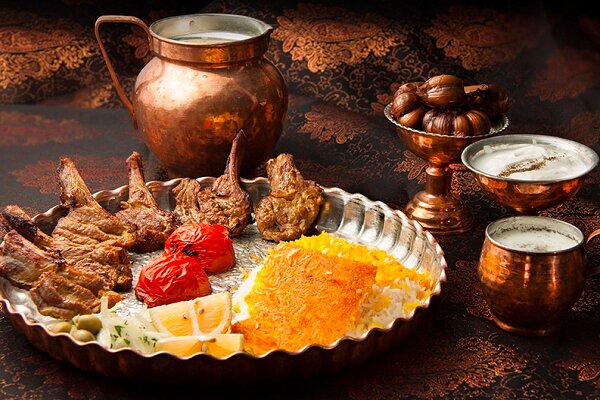Razabi Khorasan is one of Iran’s most important religious states due to the existence of the shrine of Imam Reza (AS) and has a rich cultural background in all areas, including food. People in this area cook traditional foods except for certain ceremonies and events that have excellent taste and smell.
Shoal Mashhadi:

Shoal Mashhadi is one of Mashhad’s most popular and delicious traditional foods, dating back to the Kajal era, called the city’s shawl, and the inhabitants of Mashhad cook shawls at religious rituals.
The shawl is a heavy and popular food that could be served as a main course. Shoal Mashhadi are usually spicy and rich, with a harem-like elastic appearance, but they contain different ingredients. The ingredients in shawl are rich spices such as beef and boneless lamb meat, tail fat, onion, bulgar wheat, rice, white beans, pinto beans, peas, nutmeghindi powder, ginger powder, cardamom powder, black pepper, salt and more. However, the main ingredient in Haleem is wheat. This food is very expensive and requires a long time to cook. Therefore, it is not considered a daily meal for cooking at home. This local and traditional food is cooked in a variety of ways in other cities in Razabi Holasan Province. In its original form, it usually serves a long one with small gheimeh and Sangak bread, cheese and vegetables.
Shishlik:

The world’s popular Sishrik is one of the most expensive and traditional Iranian dishes. It is made of six lamb rib bones. In Persian, the word “shish” means six, and “lik” means rib. The recipe for marinating ribs is the art of Holasanian chefs who attract thousands of tourists each year from various parts of Iran and neighboring countries to Shandis.
Traditionally, Shishrik is served with rice and barbecue tomatoes, but it also serves side dishes such as fresh onions and various types of pickles.
Jooshvareh:

Jooshvareh Ash, or Jooshpareh, is an asse made with horasan, especially razabi and south horasan, cook samosas with samosas in water and no meat is required.
Samosas or jushuvare were originally a staple food for the Horasan, but in the Horasan, the samosa was prepared and laid out with ingredients (vegetarian substances in peas), folded together, squeezed together, and boiled in water. And while ash was made to be called Jooshvareh Ash, today it is fried in oil rather than boiling, and this method is common in most parts of the world today. However, south of Horasan, boiled samosas are still common in the village as a delicious soup.
Digcheh:

Digche is the famous Mashhad dessert, cooked at religious rituals such as iftar in Ramadan. Also, locals are used to serving digche for breakfast. This traditional Mashhad dish contains milk, rice, sugar, saffron, cardamom, butter and rose water. To prepare the digche, locals first boil the rice, then add milk and let it cook. After that, we added the remaining ingredients and allowed to brew for 30 minutes.
ash-e lakhshak:

The food comes from Gonabad. The lakhshak is a thin, rather square-shaped dry dough. Other ingredients include lentils, green onions, spinach and salted water.
The broad noodles, called Lakhshak, are the main ingredient in this local Mashhad dish. To prepare this delicious dish, locals first cook the lentils. Next, add the chopped greens to the pan and cook thoroughly. Finally, they add lakhshaks and pour the curd into the pan after a few minutes. They usually use fried onions and dried mint to garnish this traditional mashhad dish.
Khoresht-e rivas or rhubarb stew:

Some Iranian cuisine has many fans of sour food. Therefore, Ribas stew is one of the best meals in Mashhad and is cooked in other parts of Iran, including Kordestan.
“Rivas” means rhubarb, and the use of this vegetable makes Khoresht-e rivas sour. This traditional Mashhad dish contains lamb or beef, rhubarb and several herbs, and is served with rice, just like other Persian stews.
Edited by Mohaddeseh Pakravan

